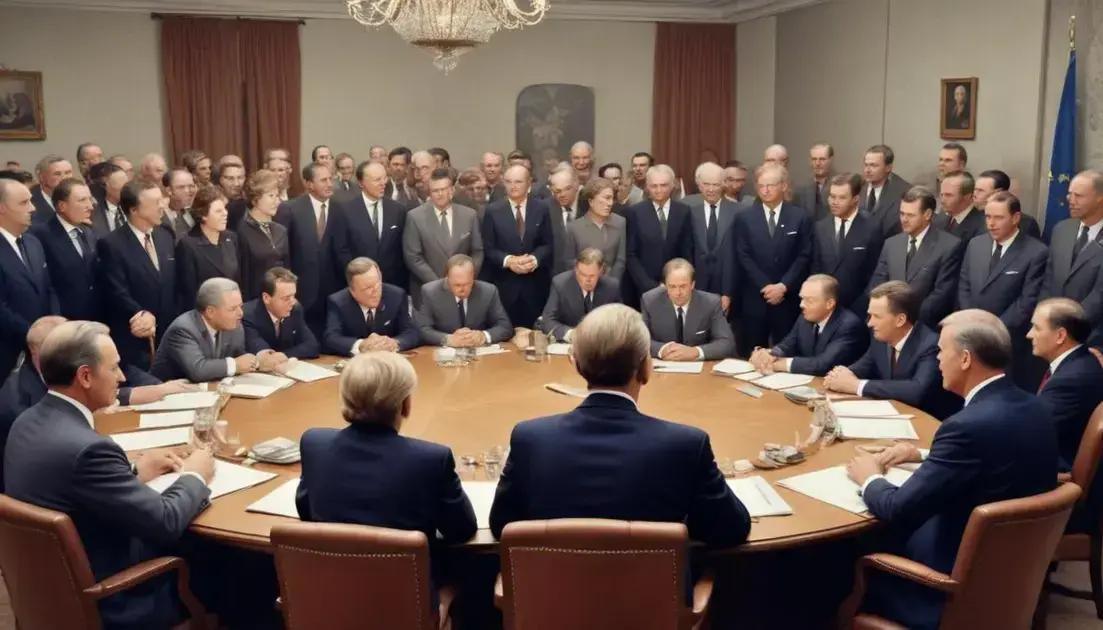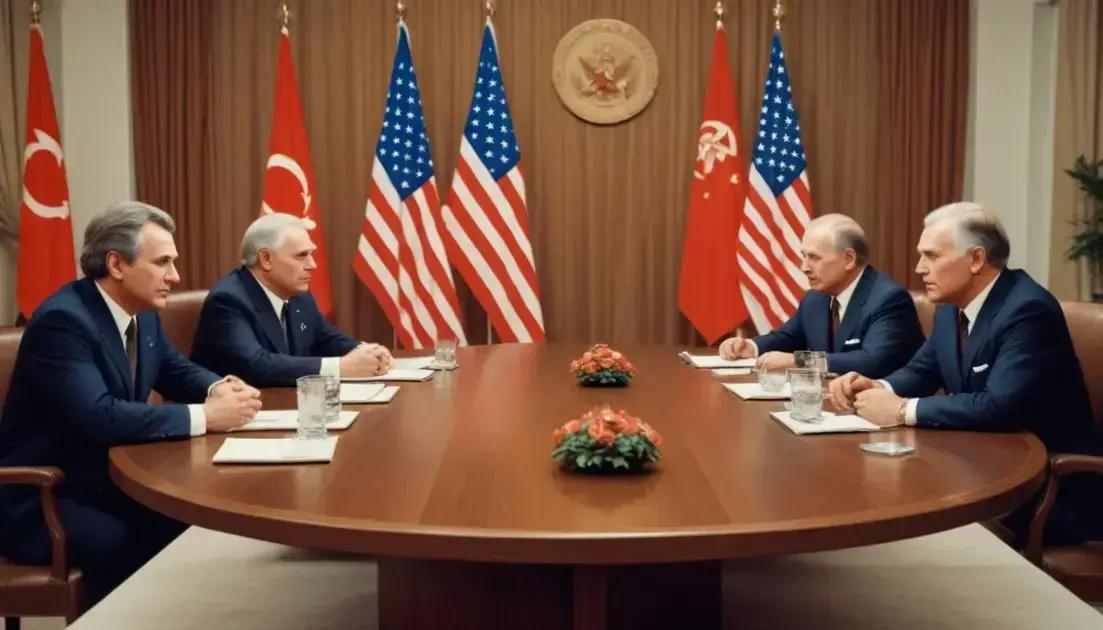
Technological Race: The Scientific Legacy of the Cold War
The Cold War significantly shaped modern society through advancements in technology, culture, and politics. Key innovations like nuclear energy and information technologies emerged, while cultural movements sparked social change. The ongoing effects of this era influence today’s global political landscape and technological developments, highlighting the importance of cooperation and the lessons learned from history.
The Cold War was more than just a political standoff; it was a fierce competition that sparked remarkable advancements in science. Curious about how these innovations still affect us today? Let’s dive in!
The Competition’s Origins
The origins of the Cold War stem from deep-rooted tensions after World War II. As countries began to rebuild, they split into two main camps. The U.S. and its allies favored democracy and capitalism. Meanwhile, the Soviet Union promoted communism. This division created a fierce competition.
Post-War Tensions
After the war, both superpowers wanted to spread their ideologies. The U.S. viewed communism as a threat to freedom. Conversely, the Soviet Union saw capitalism as a way of oppression. This clash led to an arms race and constant rivalry.
Key Events
Several key events marked the early years of the Cold War. The Berlin Blockade in 1948 showed the U.S. commitment to its allies. The Korean War from 1950 to 1953 represented direct conflict between the two sides. Each incident fueled mistrust and competition.
Propaganda and Competition
Both superpowers used propaganda to promote their ideologies. The U.S. highlighted the benefits of democracy and consumer goods. The Soviet Union focused on equality and state control. This constant battle for public opinion played a crucial role in shaping the Cold War.
As tensions rose, countries worldwide had to choose sides. Nations in Europe, Asia, and beyond faced pressure to align with either the U.S. or the Soviet Union. This rivalry affected global politics for decades.
Nuclear Physics and Beyond
Nuclear physics played a huge role during the Cold War. It wasn’t just about bombs. Innovations in this field led to many advancements in energy and medicine.
The Power of Nuclear Energy
Nuclear energy can produce vast amounts of power. It helps to generate electricity for millions of homes. While it can be risky, scientists worked hard to make it safer. Innovations have created reactors that are more efficient and reliable.
Medical Advancements
Nuclear physics also transformed healthcare. Techniques like radiation therapy help treat cancer patients. These treatments use focused energy to target and destroy harmful cells. This has saved countless lives and improved cancer care.
Space Exploration
Beyond Earth, nuclear physics contributed to space missions. It powered satellites and spacecraft. This made deep space exploration possible. Scientists use nuclear technology to gather data and explore our universe.
The advances from nuclear physics extend into our everyday lives. From energy generation to medical breakthroughs, its impact is vast. The collaboration during the Cold War fueled many of these discoveries and shaped our modern world.
Informational Technologies
During the Cold War, informational technologies saw significant advancements. These technologies helped both superpowers gather intelligence and share information quickly.
The Rise of Computers
Computers began to play a key role during this time. They processed vast amounts of data much faster than humans. This made it easier to analyze trends and make important decisions. The development of computers laid the groundwork for today’s technology.
Communication Breakthroughs
Communication technology also evolved rapidly. The invention of satellites changed how information traveled. This allowed for real-time communication across the globe. Nations could now send and receive messages instantly, which was critical during tense moments.
Information Sharing and Security
Securing information was vital during the Cold War. High-stakes espionage was common, and both sides sought to protect their secrets. Technologies like encryption became essential to safeguard communications. This focus on security is still relevant today.
The advances in informational technologies didn’t just have military applications. They also influenced everyday life. Today’s internet and mobile devices owe much to the innovations made during this era. The foundation was laid for a connected world that we enjoy now.
Cultural Shifts During the Era
The Cold War brought many cultural shifts that changed lives around the world. As tensions rose, societies adapted in unique ways. People began to reexamine their values and beliefs.
Art and Literature
Art and literature flourished during this time. Many artists and writers used their work to express their views on the conflict. They challenged the status quo and questioned government actions. Literature reflected fear and hope, showcasing life during an uncertain era.
Media Influence
The media also played a vital role. News broadcasts reported on events, shaping public opinion. Documentaries and films brought stories of the Cold War into homes. This helped people understand the reality of the conflict.
Social Movements
Social movements gained momentum in response to the Cold War. Peace activists advocated against nuclear weapons. Others fought for civil rights and personal freedoms. These movements inspired people to stand up for their beliefs.
As different cultures clashed, a global identity began to emerge. Youth across the globe connected through shared experiences. The collective push for change laid the groundwork for future generations. This cultural shift has had lasting effects that influence our world today.
Lasting Effects on Today
The Cold War left a mark on our world that we still feel today. Many of its effects continue to shape modern society. From politics to technology, the impacts are far-reaching.
Political Landscape
After the Cold War, the political landscape changed dramatically. Countries once divided began to unite. This shift affected global politics, creating a new world order. Nations learned the importance of collaboration to avoid past mistakes.
Technological Advances
Technological advancements from the Cold War era are part of our lives now. Innovations in space technology, communication, and computing started during this time. These developments paved the way for the internet and modern smartphones.
Cultural Influences
Culturally, the Cold War influenced music, films, and art. Many artists still draw inspiration from this historical period. Pop culture often reflects themes of competition, peace, and human rights. This connection helps new generations learn about the past.
The emphasis on diplomacy and international relations continues to impact today’s world. Many organizations work to promote peace and understanding. By learning from the Cold War, we seek to create a better future.
Conclusion
In conclusion, the effects of the Cold War continue to shape our world today. From political changes to technological advancements, we feel its impact in many aspects of life. The lessons learned during this time remind us of the importance of cooperation and understanding.
Technological innovations from the Cold War help create our modern conveniences. We must also value cultural influences that drive progress and creativity. By reflecting on this era, we can build a brighter future that avoids past mistakes. It’s essential to recognize how history guides us as we navigate today’s challenges.


